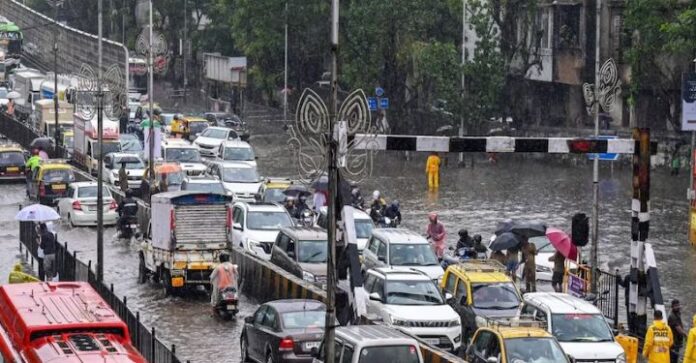Mumbai, a city accustomed to heavy rains, found itself overwhelmed on May 26 as an unusually fierce monsoon arrived early and brought with it record-breaking downpours. The India Meteorological Department (IMD) issued a Red Alert for the city and neighboring regions including Thane, Raigad, and Palghar, warning of extremely heavy rainfall at isolated places.
The suddenness and scale of the weather event caught many off guard, halting transportation, flooding homes, and raising serious questions about the city’s infrastructure preparedness.
Early Arrival, Extreme Impact
Monsoon rains are not new to Mumbai, but the magnitude and timing of this year’s onset shocked even seasoned meteorologists. The Colaba weather observatory recorded 439 mm of rain — one of the highest single-day totals for May in over 100 years. The Santacruz observatory also logged 74.3 mm in just nine hours.
What was initially forecasted as a moderate depression in the Arabian Sea quickly intensified, delivering a deluge that triggered landslides in parts of suburban Mumbai, flooded roads and railway tracks, and left neighborhoods like Sion, Kurla, Malad, and Parel under knee-deep water.
Commuter Gridlock and Service Shutdowns
Mumbai’s reliance on local trains and roadways turned into a nightmare for thousands of commuters. Train services on the Central, Harbour, and Western lines were cancelled or delayed, stranding workers and students. At CSMT, water levels rose above the platform, causing officials to suspend services for safety reasons.
The city’s roads didn’t fare better. Major thoroughfares like the Eastern Freeway and S.V. Road were submerged in floodwater. Vehicles were stuck for hours, and many had to be abandoned in waist-deep water. Cab aggregators and auto-rickshaw drivers suspended operations in the worst-hit areas, and public buses were either cancelled or rerouted.
Chhatrapati Shivaji Maharaj International Airport reported delays in both domestic and international flights. Runway visibility dropped, and ground operations slowed due to safety concerns.
Urban Flooding: A Recurring Crisis
Urban flooding in Mumbai is becoming a grim annual ritual, despite repeated promises of improved drainage and flood-mitigation strategies by civic authorities. The Brihanmumbai Municipal Corporation (BMC) admitted that only 71% of pre-monsoon desilting was completed by mid-May — a figure that drew criticism in light of the early monsoon arrival.
In Hindmata and Dadar — known flood hotspots — newly installed stormwater tanks failed to activate on time due to power and coordination failures. Complaints also poured in from residents of areas like Ghatkopar, Bandra, and Wadala, where floodwater entered homes, damaging furniture, electronics, and food stocks.
Emergency Protocols Activated
The state government and BMC swiftly activated emergency response protocols. All schools and colleges were closed, and companies were asked to allow employees to work remotely. Rescue boats were deployed in low-lying areas, and temporary shelters were opened in municipal schools.
The National Disaster Response Force (NDRF) deployed five teams in Mumbai for swift water rescue and evacuation. In parts of Andheri and Kurla, citizens were rescued from flooded apartments and shifted to dry areas. Hospitals were put on emergency footing, with ambulance routes altered and power backups tested.
Public Sentiment and Community Resilience
Despite the chaos, the spirit of Mumbai was visible in community-driven efforts. Local NGOs distributed food and drinking water to stranded residents. Volunteers helped elderly citizens relocate to higher ground. Social media became a vital lifeline, with citizens sharing updates on safe routes, helpline numbers, and availability of shelter.
At the same time, public sentiment toward civic authorities turned sour. Hashtags like #MumbaiFlooded and #BMCFailure trended on X (formerly Twitter), as netizens questioned the lack of preparedness.
Forecast and Next Steps
According to the IMD, heavy to very heavy rainfall is expected to continue for another 48 hours. The city is also expected to witness high tides exceeding 4.7 meters, which could worsen flooding in coastal areas such as Worli, Marine Lines, and Versova.
Citizens have been urged to stay indoors, avoid unnecessary travel, unplug electronics, and keep emergency kits ready. Schools will remain closed until further notice.
Urban planners and environmentalists are calling this a wake-up call. They emphasize the need for better climate adaptation strategies, improved waste management, and strict regulation of construction in flood-prone zones.

